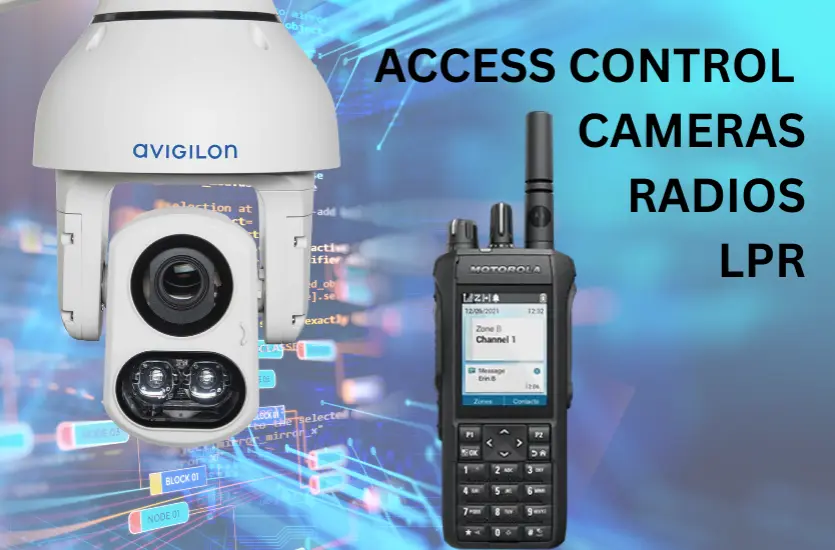Physical security now requires more than cameras on walls or guards at doors. Threats move fast, often mixing digital tactics with real-world risks that demand coordinated protection. A layered security strategy connects systems like Avigilon video surveillance, Vigilant license plate recognition, Avigilon access control, and Motorola radios into one responsive ecosystem. Each layer works together, capturing context, closing blind spots, and enabling faster communication, so your team can detect issues sooner, respond decisively, and protect people, property, and operations without fail.
The Call for a Layered Physical Security Strategy
Businesses across Florida are under growing pressure to protect employees, assets, and data from evolving physical threats. From unauthorized entry and tailgating to vehicle and catalytic converter theft, criminals are testing every weak point. Organized retail crime, vandalism, workplace violence, and perimeter breaches add another layer of concern, especially for facilities with large campuses, parking lots, or multiple entry points.
These risks don’t stop at the physical door. Increasingly, incidents serve as gateways to IT systems through badge cloning or social engineering, blurring the line between physical and digital security. The result can be operational downtime, safety concerns, liability claims, rising insurance costs, and long-term damage to reputation.
Modern solutions require coordination. As an example, license plate recognition (LPR) technology now connects plate detections to real-time alerts and searchable records, helping teams recognize patterns, identify suspicious vehicles, and investigate incidents faster. Combined with video analytics, access control, and secure radio communication, LPR forms a critical layer in an integrated defense that strengthens every part of your operation.
What “Layered” Means in Your Physical Security Strategy
A layered physical security strategy builds strength through overlap. Each component is designed to support the next to detect, delay, and respond before threats escalate. Rather than relying on a single system, this approach unites people, processes, and technology into a cohesive defense that closes gaps and creates actionable insight in real time.
Comprehensive security encompasses five essential layers:
- Physical protection: Secure perimeters, controlled entry points, and environmental safeguards.
- Network and cybersecurity: Firewalls, data encryption, and monitoring that protect connected devices and video systems.
- Access control and identity management: Role-based credentials that regulate who enters, when, and where.
- Surveillance monitoring: Intelligent video and License Plate Recognition (LPR) tools for verification and analysis.
- Incident response and crisis management: Radios, alerts, and playbooks that coordinate teams and guide decisions.
Together, these layers deliver measurable results: fewer blind spots, corroborated video and access data, faster communication between security personnel, and safer daily operations.
Core Components and How They Fit Together
A layered strategy only works when every system communicates seamlessly. Video analytics, license plate recognition, access control, and two-way radios must share data in real time, turning isolated alerts into coordinated action.
By connecting Avigilon, Vigilant, and Motorola Solutions platforms, EMCI Wireless helps organizations create an intelligent ecosystem that strengthens awareness, accelerates response, and reduces security blind spots across facilities of any size.
Avigilon Video Security and Analytics
Avigilon Unity combines on-premises video management and access control with cloud-enabled tools for smarter oversight. Using advanced AI analytics, the system identifies unusual motion, unattended objects, or recognized persons and vehicles of interest. Operators can instantly review footage, verify incidents, and share clips across devices.
Consider this example: When an unattended bag is detected, Avigilon automatically tags the event, bookmarks relevant footage, and sends a visual alert through Motorola radios for immediate on-site response.
License Plate Recognition (LPR)
Vigilant Vehicle Manager, part of Motorola Solutions, provides fixed and mobile tools to identify and track vehicles in real time. The system captures plate data, cross-references hotlists, and supports searches to strengthen investigations. LPR analytics extend situational awareness beyond building walls and into surrounding lots and streets.
Consider this example: When a banned vehicle enters the property, the system flags the plate, sends a notification to security, and triggers an instant alert to the nearest radio talk group.
Access Control and Identity Management
Avigilon Alta Access offers flexible, cloud-based control, while Avigilon Unity Access delivers robust on-prem management. Together, they give organizations scalable, role-based credentialing with mobile badge options and seamless video linkage. Doors, schedules, and permissions can be managed from a central interface, improving oversight and audit trails.
Consider this example: A forced door after hours triggers the system to pull up live camera footage, automatically alert security via radio, and send push notifications to designated managers.
Radios and Incident Communications
MOTOTRBO digital radios and APX P25 radios provide the critical communication link that ties every layer together. Integrated with video and access control alerts, these radios deliver both voice and text messages instantly—no Wi-Fi dependency, no delay. Teams can coordinate actions, verify details, and confirm containment without relying on cell networks.
Consider this example: When an LPR alert or door alarm is triggered, an automated talkgroup message is sent to nearby units, who acknowledge receipt and respond within seconds.
A Layered Stack Addresses Threats and Vulnerabilities
No single tool can protect every inch of a facility. Threats emerge from multiple directions. Some are planned and others are opportunistic, which is why a layered stack must combine detection, verification, and coordinated response. Integrating systems such as Avigilon video analytics, Vigilant LPR, and Motorola radios allows teams to act quickly with clear context, whether responding to everyday incidents or high-impact events.
Examples of how a layered approach mitigates risk:
- Vehicle-as-a-weapon or VBIED attacks: LPR systems monitor approaching vehicles, analytics flag erratic movement, and access control restricts perimeter gates to slow entry.
- Unauthorized entry: Door-prop alarms trigger nearby camera verification while radios instantly dispatch security for on-site confirmation.
- Parking lot risks: LPR hotlists identify stolen or suspicious vehicles; PTZ cameras automatically track movement; radio alerts direct patrols for real-time intervention.
- Tailgating: Access analytics and camera-based people counting identify when someone enters behind another badge holder, prompting immediate review or alarm.
- Insider risk: Anomalous badge use or off-hours access prompts a cross-check with video records and an automatic supervisor notification.
- After-hours incidents: Schedules, zone restrictions, and mobile alerts to on-call staff help prevent unauthorized access and improve response readiness.

Standards and Frameworks to Anchor Your Layered Physical Security Strategy
Building an integrated security ecosystem is more effective when it aligns with recognized frameworks. National standards help organizations create consistent policies, measure performance, and bridge the gap between physical and digital protection. These benchmarks also support compliance efforts and demonstrate due diligence during audits or investigations.
- NIST Cybersecurity Framework (CSF) 2.0: Organize your program around the five core functions: Identify, Protect, Detect, Respond, and Recover. Use these categories to map how facility controls, such as access and monitoring, support cyber-physical resilience.
- NIST SP 800-171: For organizations managing controlled unclassified information, link physical access, surveillance, and log retention to formal security policy and reporting requirements.
- Operational Technology (OT) and Industrial Control Systems (ICS): Evaluate connections between physical entry points and critical infrastructure. Test interfaces, maintain system backups, and confirm redundancy for essential controls.
- Policy layer: Support standards through clear procedures covering employee badging, visitor management, alarm response, and evidence retention, making sure every layer follows the same rulebook.
How to Deploy a Layered Framework
A layered security strategy delivers the best results when deployed methodically, evaluating vulnerabilities, integrating systems, and refining procedures over time. The goal is to transform individual tools into a connected framework that supports situational awareness and rapid decision-making across every site.
Assess and Design
Begin with a comprehensive site walk that examines entrances, parking areas, docks, lobbies, executive suites, and server rooms. Build a risk register that captures the likelihood and impact of threats, current controls, and any gaps. From there, create an architecture plan that identifies where to deploy Avigilon Unity or Alta components, maps LPR camera placements, assigns Motorola radio talkgroups, and establishes clear alerting and escalation paths.
Implement and Integrate
Connect each access point with the nearest camera to give context to every entry event. Configure LPR watchlists and retention policies in line with corporate and legal standards. Integrate alarms and analytics with radio talkgroups and mobile notifications for instant alerts. Correlate related events, such as forced doors, invalid badge attempts, or tailgating, to simplify and improve investigation and shorten response time.
Run and Improve
Security readiness depends on repetition and review. Conduct monthly alarm-to-dispatch drills and quarterly tabletop exercises to test incident workflows. Track performance metrics like time-to-detect, time-to-notify, time-to-respond, false-alert rates, and camera uptime. Revisit analytics, access zones, and radio playbooks quarterly to fine-tune performance and strengthen coordination across your layered ecosystem.
Applying a Layered Physical Security Strategy to Your Industry
Every industry faces distinct risks, yet all benefit from a coordinated framework that blends visibility, control, and rapid communication. A layered physical security strategy adapts to each environment. This protects assets, staff, and guests while improving daily operations.
- Retail and distribution: Deter organized retail crime with connected cameras and LPR systems that monitor loading docks, parking lots, and delivery zones. Use radio-guided communication to intercept suspicious activity and keep inventory secure.
- Manufacturing and utilities: Divide facilities into perimeter zones and critical interior areas. Manage contractor credentials through role-based access control, monitor tool-crib access, and use two-way radios to coordinate mustering points during drills or emergencies.
- Education and campuses: Enhance safety with visitor management systems linked to access control, enforce parking rules through LPR, and restrict after-hours access. Connect alerts directly to campus police radios for coordinated responses and faster lockdown procedures.
- Hospitality and venues: Monitor back-of-house entry points, manage event crowd flow at entrances and exits, and flag parking anomalies through real-time surveillance. Bilingual radio talkgroups help staff communicate clearly across teams during high-traffic events or emergencies.
Why Partner with EMCI Wireless
At EMCI Wireless, we specialize in bringing every layer of your security ecosystem together, including radios, video, LPR, and access control, all from one trusted source. As a certified Motorola Solutions channel partner, our team designs and implements fully integrated systems that improve situational awareness, strengthen coordination, and reduce response times. From consultation to ongoing support, we help businesses across Florida build reliable, future-ready protection.
- Expertise: Motorola Solutions channel partner offering end-to-end solutions in two-way radios, Avigilon video systems, Vigilant LPR, and Avigilon access control.
- Integration services: Complete design, deployment, and training support across Avigilon Unity and Alta platforms, Vigilant LPR systems, and Motorola MOTOTRBO and APX radios.
- Local presence: Florida-based offices providing hands-on installation, upgrades, and maintenance for clients across the region.
- Outcome focus: Our integrated approach delivers faster detection, clearer context, and more coordinated dispatch across every layer of your operation.
Are you ready to strengthen your security strategy? Request a site assessment with EMCI Wireless today. We’ll review your current systems, identify risks, and provide a tailored plan for a layered design that supports your safety goals and operational needs.

